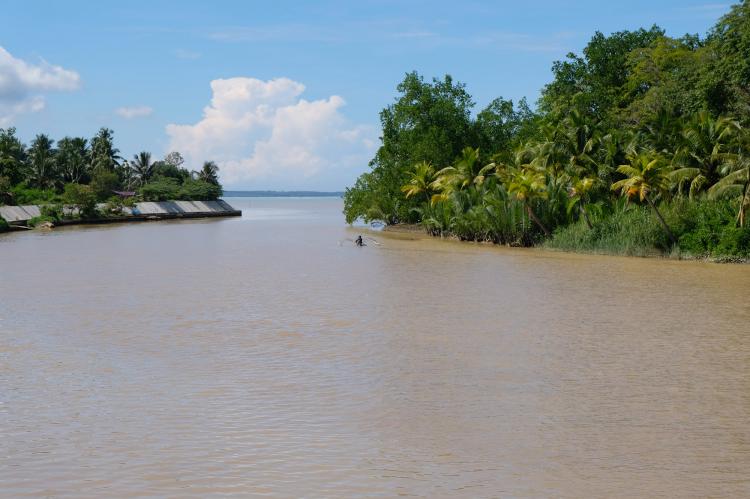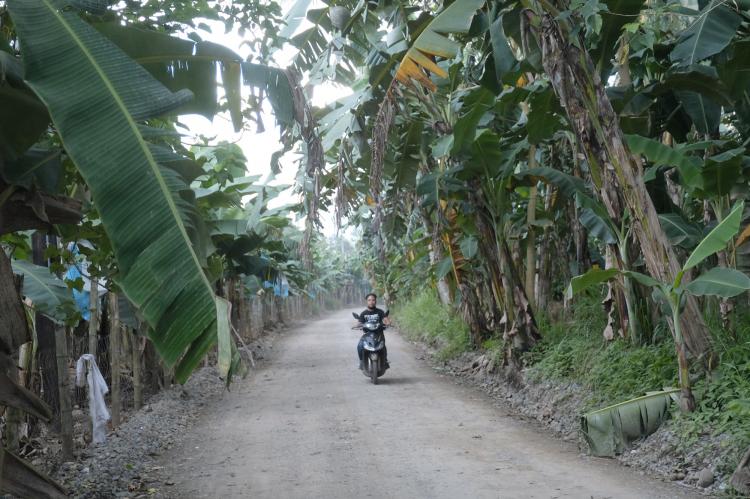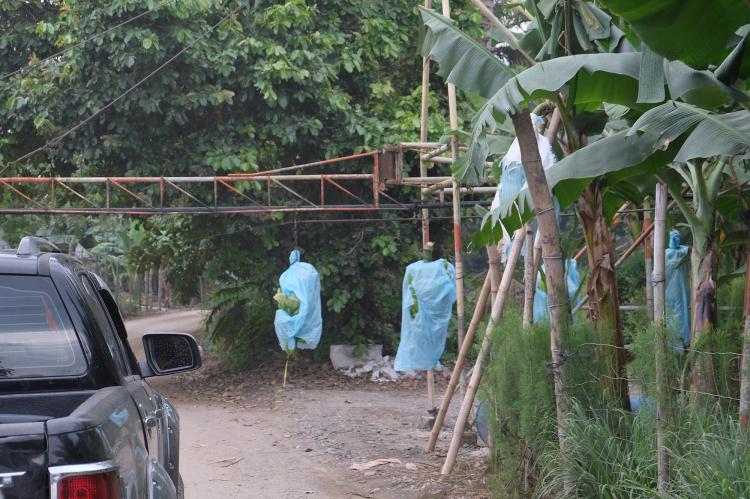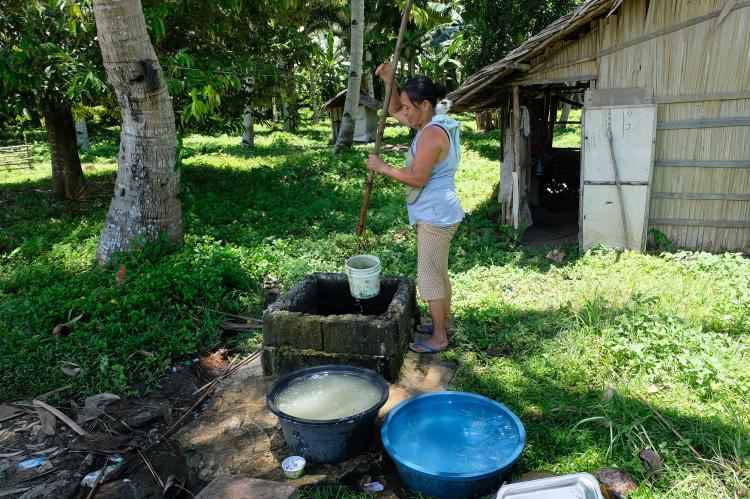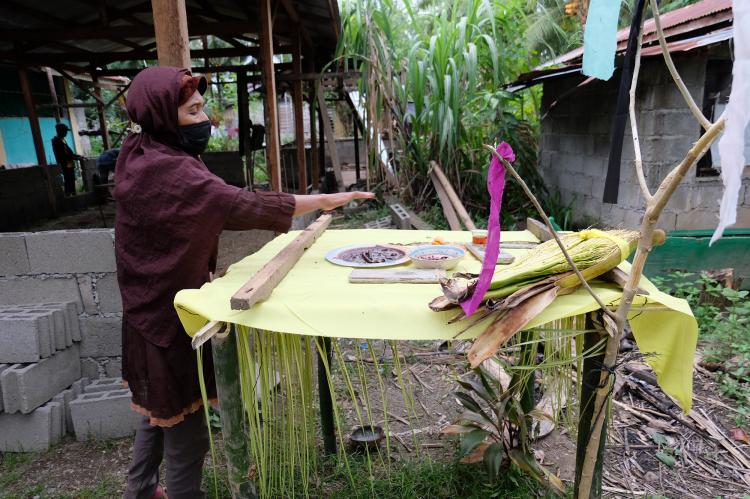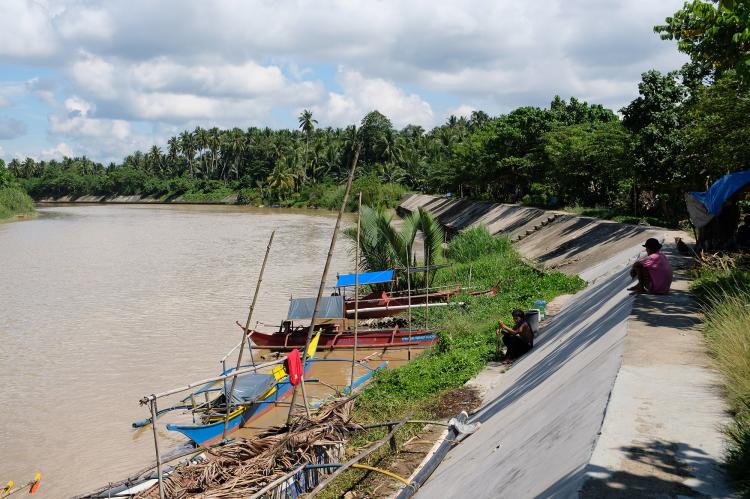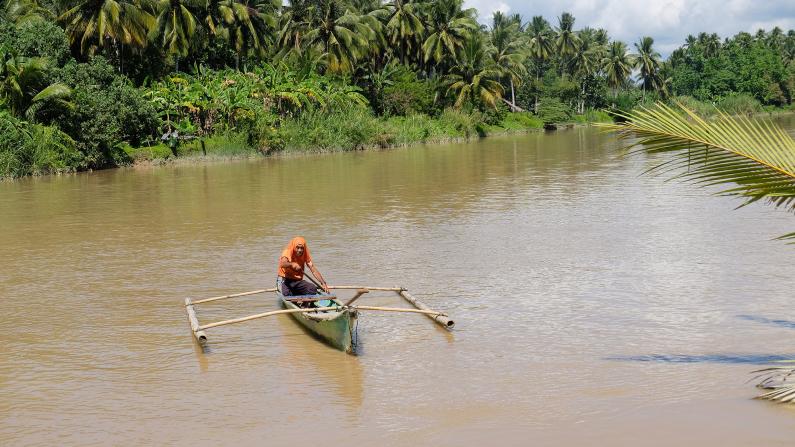
The Kagan and Mansaka tribe thrive in an area with plenty of gold in the Davao Region. Aptly so, their province was named Davao de Oro. In Spanish, “oro” means gold. With the precious metal’s contribution, local officials would even greet others with “Gold Day!” instead of “Good Day!”
During the early civilization in Mindanao, the Kagans were already occupying coastal areas on the island. The tribe embraced Islam, and when Christianity was brought in by Spanish missionaries in the early 1500s, some of them decided to become Christianized, and called themselves “Mansaka.”
Since then, the Mansaka settled in the upland areas while the Kagan remained in the coastal and riverside areas. For centuries, the two tribes lived in harmony and even engaged in intermarriage until mining disrupted their coexistence in recent decades.
Diabo, who heads the Council of Elders of the Kagan tribe in the town of Maco, inherited an area within Sanguwan Island, which is along Hijo River that drains at the vast and marine-resource rich Davao Gulf. Straddling a dozen towns, the Davao Gulf is a breeding ground of small and large pelagic fishes and hosts endangered species such as whale sharks, sea cows and sea turtles.
A villager paddles on a canoe from the brownish waters of Hijo River to the mouth of the Davao Gulf in Maco, Davao de Oro province.
“During my childhood days, the water at the Hijo River was crystal clear. We drink, bath and wash our clothes in the river,” he recalls from a hut just a few meters from the riverbank.The whole stretch of the Hijo River, as far as the eyes can see from where Diabo lives, is murky, with the riverbed invisible due to the brownish waters.
He blames mining activities by big mining companies and small-scale illegal miners in the upland areas of the towns of Maco for the sorry state of the Hijo River.
Diabo describes mining “as the biggest disruption to their lives,” saying it deprived them of potable drinking water and source of food and livelihood, as their water wells on the island have become contaminated and the fish that they catch for food and to sell to the markets became scarcer.
“Back then, it’s easy to catch fish for our communal gathering. We would invite Mansaka friends to partake in our feast. We can catch fish just several minutes after throwing the hook off to the water. The catch would be too much for the feast,” he says. “Nowadays, you can’t catch fish at the river even for one meal even if you fish all day. In the past, the water was crystal clear that you can see fishes swimming in the riverbed,” he adds.
Not only the mining activites and banana plantations are giving a hard fight to the indigenous peoples, but also climate change issues complete new challenges. Banana plantations abound in the area and had been blamed for the siltation of Hijo River. The tribal elder laments that climate change affected the river that some fish, due to warming temperature, have vanished. At the same time, the weather becomes more and more unpredictable, rainy or sunny, which has taken a toll in their farming practices.
This became again visible when the COVID-19 pandemic emerged last year. The Kagan tribe established a vegetable farm and fish ponds on Sanguwan Island in a bid to help members cope up with the impact of the epidemic that continues to ravage the economy of many countries around the world. The venture aims to make members of the Kagan tribe self-reliant and to provide alternative livelihood to community members. Three hectares were developed for the communal vegetable farm. They built ponds that did not disturb the mangroves and stocked it with tilapia, milk fish and crabs.
Disaster, however, struck their venture after the Hijo River overflowed following strong rains, which Diabo believes is an effect of climate change. The flood wiped out the communal vegetable farm and washed out most of the marine stocks at the ponds after they overflowed. Out of the 5,000 milkfish fingerlings that were dispersed, the Kagans managed to harvest only 70 kilos. At least PHP300,000 (5,000 Euros) worth of investments went to naught due to the flood.
Hadji Abdulrahman Diabo points to a fish pond on Sanguwan Island that was destroyed by a flood in 2020 in Maco, Davao de Oro.
Tribal conflict
The gold mining activities in the upland areas of Maco town have triggered a friction between the Kagan and Mansaka tribes. The Mansaka tribe granted rights to Apex Mining Company, a Filipino-owned company, to operate within a portion of the tribe’s 100,000-hectare ancestral domain, entitling them to receive a royalty fee from the company.
On the other hand, the Kagan’s ancestral domain claim covers 8,000 hectares over land and 13,000 hectares over water, including the Hijo River. The Kagan tribe does not get a share from the royalty fee paid by Apex to the Mansaka tribe.
Ruelo Deporkan, a member of the Kagan tribe who sat as indigenous people’s representative to the Maco municipal council in June 2021, says the situation “is unfair to them.” “The Mansaka enjoys the benefits while the Kagan catches the bad effects of mining,” he says. “What the Kagans get are illnesses from the polluted Hijo River.”
But Deporkan clarifies that he is not totally blaming Apex nor the banana companies that operate in Davao de Oro province and neighboring Davao del Norte as the only culprits for the river’s pollution, since many illegal miners and land reform beneficiaries or individual farmers in the banana industry also operate in the area.
Earth-shaking equipment extract sand and gravel from the ancestral land of the Kagan tribe in Maco, Davao de Oro.
‘Responsible mining’
Last year, Apex marked its 50th year and released its first sustainability report, which details the “company’s integrated approach to responsible mining.”
The company, Maco town’s top taxpayer for years and provider of jobs to almost 2,000 people, noted that stewardship of the environment “remains its key priority” and that it faithfully keeps to the provisions set by Philippine mining regulations. In 2019, it spent around PHP88 million (1.48 million Euros) for various environmental protection and enhancement programs. In a statement, Luis Sarmiento (no relations to the writer), Apex president and chief executive officer, described Apex as “a responsible mining company.” “We equate sustainability with inclusivity.”
Deporkan points out that the national and local governments “favor the interest” of big mining investments, because of the huge taxes and employment that they generate, over the welfare of the ordinary folk and the environment. The government turns a blind eye in the case of Hijo River, he adds, noting that its water will remain brown due to mining activities in the upland area.
“For the Kagan tribe, Hijo River used to be our market and a source of traditional medicine and food. But now, what you can get from the river is sickness,” Deporkan stresses, urging the government to intensify their monitoring to pin down the culprit of the river’s pollution.
A woman fetches water on a well on Sanguwan Island in Maco, Davao de Oro. The water from the well is not potable and used only for washing clothes and dishes.
Unequal power sharing
For the last nine years, the Mansaka represented the indigenous peoples to the municipal council or the local legislative body. Starting this year, it was the turn of the Kagan tribe, represented by Deporkan. However, the Mansaka tribe wants to regain the seat after Deporkan’s three-year stint ends in 2024 because the former asserted that they are the dominant tribe in the community.
Deporkan says the Kagan tribe is seeking for a fair rotation and that the matter has been brought to the national government for decision. “The Kagan accepted the Mansaka’s term for three terms, and that’s our sign of respect to them. Now that it’s our turn as indigenous representative, we hope the Mansaka will respect that also,” he says.
During the three terms with the Mansaka as tribal representative, Deporkan laments that the Kagan tribe was allegedly neglected by the former “as if our tribe did not exist.” Deporkan said his top priority is closing the gap between the two tribes, by initiating dialogues and visiting Mansaka leaders and communities. As a first tangible step, he hired legislative aides from both sides, something not done when the Mansaka was at the helm.
“The Kagan tribe wants peace and understanding with the Mansaka tribe. I want to restore our harmonious relationship like what we had in the olden days,” he stresses.
Non-violent conflict transformation initiative
To make things better, Deporkan is not alone in his bid to bring back the harmony and trust between the Kagan and the Mansaka tribes. Helping him is the Learned Kagan Muslim Foundation, Inc. (LKMFI), an organization existing for about two decades with over 100 members, including young professionals. Since last year, forumZFD partnered with LKFMI to foster peace among the tribes and other stakeholders in Davao de Oro province.
They partnered in a project promoting non-violent conflict transformation, wherein forumZFD is strengthening the capacity of LKMFI to resolve conflicts using dialogues while further developing the group’s organizational capacity. Prior to conducting the capacity-enhancement activities, forumZFD invested a lot of time in laying down the groundwork, particularly in building trust with LKMFI and the leaders of the Kagan tribe.
A Kagan woman explains a religious ritual to heal a sick person in Maco, Davao de Oro.
“Our goal is to champion dialogue as a means for resolving conflicts,” said Gabrielle Sagaral, forumZFD project officer. “The Kagans employ their indigenous conflict resolution mechanisms for micro conflicts within their communities. While these mechanisms are difficult to employ for broader, more complex conflicts like the dispute over mining royalties, they nevertheless provide a basis forumZFD’s work can build on,” she added. With the intervention from forumZFD, she stressed they are looking to see LKMFI engaging other actors in the region as a kind of bridge to mend the conflict between the Kagan and the Mansaka tribes.
Abdul Rasad Sawat, LKMFI acting executive director, says that dialogue is a good way to address differences rather than resorting to violent confrontation. “There have been initial talks between us and the Mansaka, not just about sharing from the royalty derived from big mining activities,” he says. “We want to restore the good relations between the Kagan and the Mansaka tribes through non-violent means.”
According to him, it is fair that the Kagan gets a share from the royalties received by the Mansaka because the former, being in the lowlands, suffer the brunt of the negative impact of mining activities in the mountains.
Sawat also suggests the strict regulation of mining activities to minimize its impact to the environment. “During the COVID-19 pandemic lockdown last year, our river became crystal clear again for two months because there were no mining operations,” he says. “Young and old individuals alike swam again in our river like in the old times when the water was clean.”
The LKMFI has conducted orientations on responsible environment practices among community members and involved them in tree planting and coastal clean-up activities to help in the conservation efforts in the area. The activities also seek to build camaraderie among the communities.
Villagers while away their time at the banks of the Hijo River, which empties to the Davao Gulf in Maco, Davao de Oro.
Norhaiya Macusang, an LKMFI member, expressed hopes that the inter-tribe conflict can be mended through dialogues, which along the way would also tackle the environmental problems facing their tribal communities, particularly Hijo River and the municipal sea waters.
According to her, once the two tribes reconcile their differences, more people, and not just from one tribe, can be utilized to restore the area’s degraded environment, through tree or mangrove planting activities and coastal clean-ups. Cooperation between the tribes will lead to a better understanding of how the mining operations and climate change are affecting those living along the coast and the Hijo river, and a more unified response to the problem can thus be explored.
Macusang had fond memories of the Hijo River and the mouth of the shoreline where the river drains. “During my childhood, the coastline where the Hijo River drains is very clear. We would swim in its clear waters,” says Macusang, the daughter of Diabo, the head of the Council of Elders of the Kagan tribe.
Macusang, who has her own family now, wishes that the possible reconciliation and unity between the two tribes will help make their environment better.
Romer Sarmiento, a Filipino freelance journalist based in Mindanao, Philippines, is a peace and environmental advocate.
